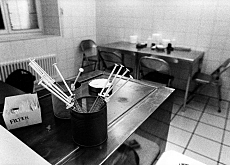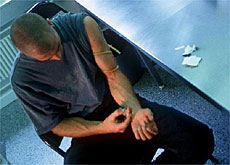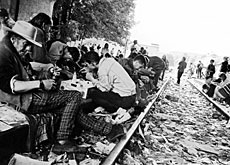Heroin loses its attraction

The liberalisation of Switzerland's drug policy since 1991 has led to a drop in the number of new heroin addicts, a Zurich University study has revealed.
But it found that since the number of addicts who managed to quit has decreased only slightly, the population of heroin users has remained relatively stable.
Sociologist Carlos Nordt and psychiatrist Rudolf Stohler examined more than 7,000 heroin users from 1991 in an attempt to evaluate trends and the prevalence of problematic heroin use in Switzerland.
Switzerland has often been criticised for its liberal drugs policy. Its harm reduction measures – such as drug consumption rooms, needle-exchange services, low-threshold methadone programmes and heroin-assisted treatments – are seen as making illicit drugs seem less harmful than they actually are.
This controversial line of action is aimed at preventing damage to the addict’s health from low-quality street heroin and at reducing drug-related crime.
Critics have claimed this policy could lead to a growing number of new users of street drugs and lengthen the period of heroin addiction.
In this week’s edition of medical journal The Lancet, Nordt and Stohler refute these criticisms by showing that the Swiss approach has resulted in a decreased incidence of heroin use and led to heroin being considered a “loser drug”.
“[In Switzerland] heroin use seems to be considered an illness that has to be treated by a doctor now, rather than a criminal act,” Nordt told Swiss public radio.
Discoveries
The researchers obtained information about the first year of regular heroin use for 7,256 patients (76 per cent of those treated between 1991 and March 2005) involved in substitution treatments in canton Zurich, which has about a quarter of all Swiss heroin users.
They discovered that every second person began their first substitution treatment within two years of beginning to use heroin regularly.
Statistics show that heroin use rose steeply from the mid-1970s, peaking in 1990 with 850 new users, and declining substantially to about 150 users in 2002.
By contrast, the number of new heroin addicts in Britain, Italy and Australia – which have repressive drugs policies – has continued to increase, which Nordt and Stohler suggest shows the public-health benefits of the Swiss policy.
However, the population of problematic heroin users dropped by only four per cent a year. The scientists explained that since the cessation rate in Switzerland was low, the prevalence rate declined slowly.
In 1996 there were 7,100 reported heroin addicts in Zurich; last year there were 6,200.
“We aren’t necessarily dealing with new heroin users anymore, but with people who have been dependent for up to 30 years,” added Nordt.
Interpretation
The study concluded that the harm reduction policy of Switzerland and its emphasis on medical treatment for users seems to have helped give heroin a bad image among young people.
Switzerland has adopted a so-called four-pillar strategy to tackle the problem that includes prevention, repression, survival help and therapy.
According to the authors, this has led to heroin use being considered an illness that requires therapy and to heroin being labelled a “loser drug” by young people.
Nordt and Stohler said the model used in Zurich could enable the study of incidence trends across different countries and contribute to assessments of the effects of different drug policies.
swissinfo with agencies
Zurich is Switzerland’s most populous canton, its 1,200,000 inhabitants constituting about a fifth of the country’s population.
Open drug scenes developed in the early 1980s in the city of Zurich, culminating in 1986-92 at the Platzspitz (“Needle Park”) and in 1993-95 at the former Letten railway station .
Drug mortality data indicate that about 25% of Switzerland’s heroin users live and die in the Zurich area.
Since 1991, there have been no requirements in the canton to qualify for substitution treatment other than being heroin dependent.
Mandatory health insurance covers the costs of treatment and patients may choose their doctor from among those who practise in the canton.
There are around 30,000 heroin users in Switzerland.
More than 1,200 heavy heroin addicts receive their drugs under strict medical supervision.
There are 21 centres and two prisons taking part in the scheme.
It takes a heroin addict 12 years on average to kick the habit.

In compliance with the JTI standards
More: SWI swissinfo.ch certified by the Journalism Trust Initiative












You can find an overview of ongoing debates with our journalists here . Please join us!
If you want to start a conversation about a topic raised in this article or want to report factual errors, email us at english@swissinfo.ch.